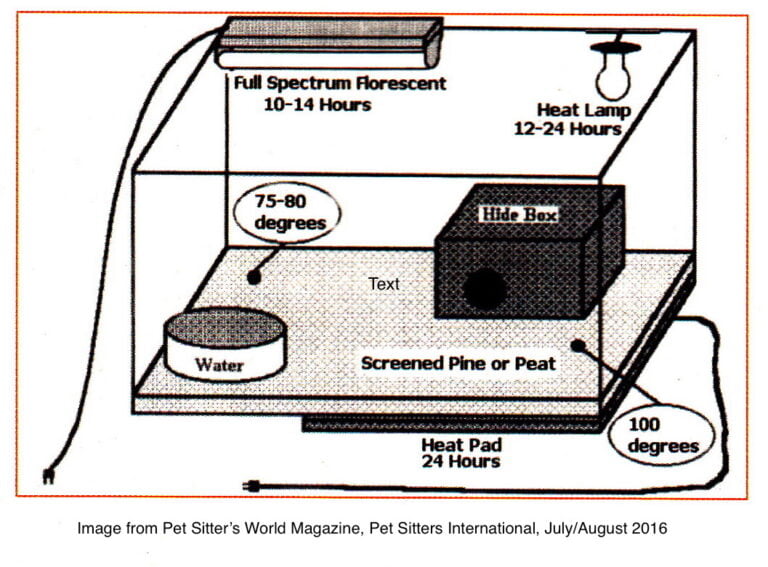Our first two articles on exotic reptile and amphibian animals reviewed the care of the Leopard Gecko and Corn Snake as reported in Pet Sitter’s World Magazine by Pet Sitters International. This third and final installment focuses on the habitat, feeding and maintenance of the tropical and desert tortoise.
Dogs and cats are some of the most common pets today in society. Many people, however, like the companionship that exotic animals like lizards, snakes and tortoises offer as pets. Exotic animals make great pets especially in places where space is a premium and furry animals (e.g., dogs and cats) are not allowed, like apartments. Moreover, the hypoallergenic nature of reptiles and amphibians provide a viable alternative for animal lovers allergic to cat and/or dog dandruff. Today’s article on tortoises focuses on the following topics:
- Habitat
- Temperature
- Water
- Bedding
- Cage Decorations
- Tank Size
- Special Lighting
- Feeding
- Daily Diet
- Vitamins
- Maintenance
- Cleaning
- Handling
- Problems
Tortoises come from warmer temperature climates ranging from desert to tropical. The species of tortoise and range of its habitat determine the environment it will need replicated. While some tortoises are no larger than a grapefruit, others can grow to the size of a wheelbarrow. Tortoises can live more than 100 years in captivity with proper care.
Habitat
Temperature
Establish a temperature range from 100° F (hot end) to 75 – 80° F (cool end). It is important to always offer the animal a choice of conditions. Additionally, heat should be provided overhead and from below.
Water
Tropical tortoises should be offered a shallow water bowl and be misted once daily. Desert tortoise cages should receive no water. Baby tropical and desert tortoises should be soaked in very shallow tepid water 30 minutes per day. Adult tropical and desert tortoises should be soaked in very shallow tepid water once a week.
Bedding
Tropical tortoises should have moist peat moss. Desert tortoises can use screened pine shavings or dry peat moss mixed with fine-grained sand.
Cage Decorations
Furnishing a hide box will provide your tortoise a warm dark place to sleep.
Tank Size
The minimum size cage/tank for baby tortoises is 15-gallons. You will need to provide larger cages/tanks as your tortoise grows. Some adults should be kept outdoors with access to a heated doghouse or shed.
Special Lighting
Providing your tortoise with a UVB light source is essential. UVB lights simulate natural sunlight that aid tortoises in metabolizing key vitamins and minerals which are essential for preventing calcium deficiencies.
Feeding
Daily Diet
Dark leafy greens, grasses, legumes, baby greens, spring mix, dandelion greens, romaine lettuce and alfalfa sprouts are favorites among tortoises. Fruits and other occasional foods (primate diet) can be offered as well. Remember that variety is important. Tropical tortoises require 75% leafy greens and 25% fruits. Desert tortoises require 95% leafy greens and 5% fruits. Adult tortoises require feeding every other day.
Vitamins
All foods require light dusting with a 50/50 mixture of calcium and vitamin supplements. These supplements are an essential part of the diet as their absence can create calcium and vitamin deficiencies in the tortoise, which are ultimately fatal.
Maintenance
Cleaning
Spot clean individual messes and uneaten food while replacing with fresh substrate daily. Use a wide screen fish net to sift sand. Entirely clean the cage bimonthly or as required.
Handling
The best way to interact with a tortoise is to let it walk on the ground with you outside on a nice day as tortoises do not like being picked up. Do not handle a tortoise for the first week after it comes into a new home. Ensure your new tortoise is eating and well adjusted to its new home prior to handling. Make sure there are no toxic plants and do not leave your tortoise unsupervised unless the yard is very secure.
Problems
As with most animals, a lack of appetite is the first sign a tortoise is unhealthy. First check to ensure the cage/tank temperatures are correct. Contact a herptile veterinarian if the environment set-up is appropriate and problems persist.
Sample Tank


